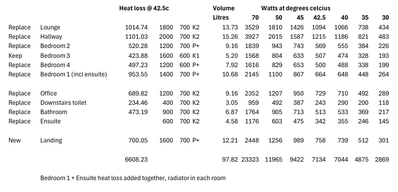Radiator sizing for heat pump installation by British Gas - are these correct?
We are booked in for a heat pump install with British Gas. So far we have been very impressed with them and it will be installed in around 10-12 weeks.
I'd like to run by your thoughts as to their radiator plans.
They look pretty sensible to me and have been designed at 42.5c (not 50c like Octopus).
They want to change all bar one of our radiators, including an additional on the landing and all much bigger than we have (which we are happy with).
They have sized the radiators at 21c in all rooms, including bedrooms. Only the bedrooms will have TRV's.
Will the bedrooms be too warm? Ideally we want to run the heat pump 24/7, with a small setback overnight.
Should we stick with the bedroom radiators at this size, or ask BG to resize them at a lower temperature?
Is it better to have the bedroom radiators oversized for greater volume and let the TRV's limit the flow to avoid overheating, or reduce the radiator sizes in the hope the TRV's won't need to kick in?
Heat pump will be a Daikin 8kw Altherma LT, 25l volumiser.
House heat loss was 6.2kw.
Attached is the radiator schedule.
Thanks.
Assuming the heat loss figures are accurate, the radiator sizings look sensible. We have Flow Regulating Valves (FRVs) installed on almost all our radiators. They make it very easy to balance the flow across all the radiators. I wonder whether they would be prepared to install them?
I am not sure whether it's OK to have TRVs as well as FRVs on bedroom radiators. Hopefully, someone else can advise.
We are finding that upstairs is about 1.0-1.5C higher than downstairs. I am not sure whether that is just natural stratification with the warm air rising from downstairs. So far, we are just running all our bedroom TRVs wide open. We find the bed is a bit cool at the beginning of the night, but we wake up a bit too warm. That may be due to our rather old Tempur foam mattress. Apparently, the latest ones breathe and release heat better. Still, it is really nice to be able to go downstairs and make a cup of tea without need to wear a dressing gown!
Grant Aerona 290 15.5kW, Grant Smart Controller, 2 x 200l cylinders, hot water plate heat exchanger, Single zone open loop system with TRVs for bedrooms & one sunny living room, Weather compensation with set back by room thermostat based load compensation
Good point about the FRVs, @grahamf. Renewable Heating Hub members get 10% off by using the discount code RHHFRV10 at checkout, if you buy from Firepower.
Get a copy of The Ultimate Guide to Heat Pumps
Subscribe and follow our YouTube channel!
Posted by: @grahamfWe are finding that upstairs is about 1.0-1.5C higher than downstairs
So why not just turn down the frvs on these radiators? There is nothing sacrosanct about the 'design' flow rate
4kW peak of solar PV since 2011; EV and a 1930s house which has been partially renovated to improve its efficiency. 7kW Vaillant heat pump.
Posted by: @bashWill the bedrooms be too warm? Ideally we want to run the heat pump 24/7, with a small setback overnight.
If bedrooms are too warm just reduce the flow rate through them by turning down the lsvs (or frvs if you can get them fitted) This reduces the average rad temp this reducing the heat emitted. That's what I and others have done.
4kW peak of solar PV since 2011; EV and a 1930s house which has been partially renovated to improve its efficiency. 7kW Vaillant heat pump.
@jamespa Thanks, I'm assuming as I'll have a decent volume of around 120ltrs + pipework, the reduced flow shouldn't make much of a difference and better than allowing the TRVs to take over too much?
With the frvs, I assume looking at the blurb, they just make the balancing easier?
Posted by: @bash@jamespa Thanks, I'm assuming as I'll have a decent volume of around 120ltrs + pipework, the reduced flow shouldn't make much of a difference and better than allowing the TRVs to take over too much?
Posted by: @bashWith the frvs, I assume looking at the blurb, they just make the balancing easier?
Trvs switch the flow off altogether so anything which reduces flow rather than switching it off is better from a flow perspective.
Frvs are as you say sold to help with balancing. However given what they do is adjust the flow rate, they can be turned down or up from the 'design' setting thus doing the same job as lsvs but with better control. Another way to look at it is that they can be used to balance the rads for equal room temp (or desired temp differences) as opposed to equal deltaT.
4kW peak of solar PV since 2011; EV and a 1930s house which has been partially renovated to improve its efficiency. 7kW Vaillant heat pump.
After months of research, that is my understanding, that you ideally don't want to remove a radiator from the system completely (the trv switching it off), as you want to keep as much of the entire system as possible flowing.
These frvs do look to be a better way than trial an error with a standard lock shield.
I assume you'd want the whole system balanced at point of install, that all radiators heat evenly.
Then as time goes by and you get a better idea of how each room heats up, you can reduce the flow to some rooms that may have a tendency to overheat, which will be pretty straightforward and more accurate with a frv.
Are these radiator frvs the same as what is used with underfloor heating?
Posted by: @bashAfter months of research, that is my understanding, that you ideally don't want to remove a radiator from the system completely (the trv switching it off), as you want to keep as much of the entire system as possible flowing.
These frvs do look to be a better way than trial an error with a standard lock shield.
I assume you'd want the whole system balanced at point of install, that all radiators heat evenly.
Then as time goes by and you get a better idea of how each room heats up, you can reduce the flow to some rooms that may have a tendency to overheat, which will be pretty straightforward and more accurate with a frv.
You are spot on.
Posted by: @bashAre these radiator frvs the same as what is used with underfloor heating?
I don't know TBH as I don't have them, they weren't available when my heat pump was fitted. They look that way though!
4kW peak of solar PV since 2011; EV and a 1930s house which has been partially renovated to improve its efficiency. 7kW Vaillant heat pump.
- 26 Forums
- 2,342 Topics
- 53 K Posts
- 494 Online
- 6,000 Members
Join Us!
Worth Watching
Latest Posts
-
RE: MELcloud scheduling misbehaviour
@downfield I wonder if it is the MELCloud app that is t...
By DavidAlgarve , 28 minutes ago
-
RE: Poll for Time of Use, tariffs, technology
@jamespa If you have no nett export then don’t do IO...
By Papahuhu , 45 minutes ago
-
RE: A Smarter Smart Controller from Homely?
I've been thinking of emailing Homely to ask for a few ...
By JohnnyB , 1 hour ago
-
Max output of Heat pump (Daikin 4Kw EDLA04)
Hello, I am a bit puzzled that according to pcdb tes...
By GeorgeA , 1 hour ago
-

In that case, @technogeek, I’d sign up for the free sol...
By Majordennisbloodnok , 2 hours ago
-

RE: Has Anyone Else Noticed a Decline in Tradesmanship?
@cathoderay Hence my rider about ‘all else being equal’...
By Toodles , 3 hours ago
-

RE: Heat Pump Performance Analysis Web App using Modbus Data
@redzer_irl — all my heat pump data is in csv files, me...
By cathodeRay , 3 hours ago
-

That’s not a problem. If you can hit the main landing p...
By Majordennisbloodnok , 4 hours ago
-

RE: Configuration issues with 10kW Midea R32 heat pump
@benson I believe there are quite a few of these instal...
By Toodles , 4 hours ago
-
RE: 10kw heat pump run in 24*7 data?
I would say you most likely do need 10kW. My gas consu...
By JamesPa , 4 hours ago
-
RE: Here is my heat pump installation with questionable COP in Italy
Well in Italy there is nothing controlling the quality ...
By materox345 , 6 hours ago
-

RE: What a Bad Heat Pump Installation Looks Like
@editor The trick to an inside unit installation is to ...
By MikeFl , 21 hours ago
-
RE: Different dT on each radiator?
The way heating systems are designed will result in rou...
By JamesPa , 23 hours ago
-

RE: Setback savings - fact or fiction?
PS by visually merging the two tables as above, I ended...
By cathodeRay , 1 day ago
-

RE: Homely for Daikin Altherma 3 - Petersfield Area
@russ If you would care to pose your questions on one o...
By Toodles , 1 day ago
-

RE: The good, the bad and the not that great – my heat pump installation
@cathoderay the guy I spoke to on the phone seemed very...
By Burtis , 2 days ago
-
RE: British Gas vs Octopus Energy vs Heat Geek vs EDF vs Aira vs OVO vs EON.Next vs Boxt
I get the impression that that comment "they don't comm...
By JamesPa , 2 days ago
-

@majordennisbloodnok Just in case there are variations ...
By Toodles , 2 days ago
-

RE: Latest NIBE model has known defect and no solution
@kings I’m glad I could help. NIBE are taking this very...
By Mars , 2 days ago






